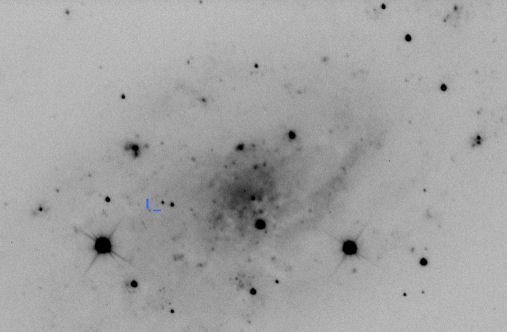LBV (SNhunt225) in NGC 2403 new outburst pinpointed by Paolo Campaner on 2nd November 2014. Also classified as PSN J07370423+6535509. Mag 18.5.

==============================================================================
ATEL #6756 ATEL #6756
Title: Spectroscopic classification and progenitor identification
of SNhunt225
Author: F. Taddia, J. Sollerman (Oskar Klein Centre and Stockholm
University), N. Elias-Rosa and A. Pastorello (Osservatorio Astronomico
di Padova)
Queries:
Questo indirizzo e-mail è protetto dallo spam bot. Abilita Javascript per vederlo.
Posted: 26 Nov 2014; 16:28 UT
Subjects:Optical, Supernovae
We report that an optical spectrum (range 330-900 nm; resolution 1.7 nm)
of PSN J07370423+6535509 = SNhunt225 (CBAT "Transient Object Followup Reports")
was obtained at the Nordic Optical Telescope (+ ALFOSC) on Nov. 24.2 UT.
The spectrum shows a red continuum with a weak, unresolved Halpha in emission.
The position of the narrow Halpha is consistent with that expected from
the modest recessional velocity of the host galaxy NGC 2403 (V_rec = 133
km/s; Sellwood & Sanchez, 2010, MNRAS, 404, 1733, via NED). The spectrum
is very similar to that of the "supernova impostor" UGC 2773 OT2009-1 (Foley
et al. 2011, ApJ, 732, 32), and therefore SNhunt225 is most likely an LBV-like
eruption of a massive star.
Using the acquisition image of SNhunt225 obtained at NOT Telescope (+ALFOSC),
we geometrically matched deep archival Hubble Space Telescope (HST; available
at Hubble Legacy Archive) image mosaics obtained with different configurations:
F439W (~B) filter taken with WFPC2 on 1994 April (GO-5383; PI: L. Drissen);
F475W (~SDSS g), F606W (~V) and F814W (~I) taken with ACS/WFC on 2004 August
(GO-10182; PI: A. Filippenko). We isolated a clear source (with a precision
between 0.05" and 0.08") in the all HST images, at the accurately measured
position of SNhunt225: R.A. = 07h37m04.189s and Dec. = +65d35m46.957s.
A finder chart for the candidate progenitor is provided at <a href=http://ttt.astro.su.se/~ftadd/positionsnhunt225_f606w.jpeg>
http://ttt.astro.su.se/~ftadd/positionsnhunt225_f606w.jpeg</a>.
Using the Dolphot package (Dolphin 2000 PASP, 112, 1383), the magnitudes
of the recovered HST source are: F439W = 20.94 +/- 0.01, F475W = 20.75
+/- 0.01, F606W = 20.43 +/- 0.01 and F814W = 20.11 +/- 0.01. Assuming a
distance modulus to NGC 2403 of 28.29 +/- 0.15 mag, as inferred from the
average recessional velocity of the galaxy corrected for the Local Group
infall into the Virgo cluster + the Great Attractor + the Shapley Supercluster
(NASA/IPAC Extragalactic Database - NED), and adopting Galactic reddening
of E(B-V) = 0.035 (Schlafly & Finkbeiner 2011, ApJ, 737, 103), we obtain
absolute magnitudes of -7.49, -7.67, -7.97 and -8.24 in the (approximate)
B, SDSS g, V and I bands, respectively, and a intrinsic colour of B-V =
0.48 mag for the HST source.
We note that the coordinates of SNhunt225 are quite close, but not coincident,
to those reported in the literature for the variable V22 in NGC 2403 (R.A.
= 07h37m04.75s, Dec=+65d35m49.7s, J2000.0;
Artyukhina et al. 1996, General Catalogue of Variable Stars, Vol. V.: Extragalactic
Variable Stars). V22 was classified as a likely LBV by Tamman & Sandage
1968, ApJ 151, 825. However, from a visual inspection of the identification
map (Figure 3 in Tamman & Sandage, 1968), we suggest that SNhunt225, the
recovered HST source and the historical V22 may be the same object.
The approximate B-band magnitude in the HST image is consistent with those
observed for V22 by Tammann and Sandage from 1910 to 1963 (in the range
20.2 to 21.8 mag; see their Figure 10).
For this reason, we cannot rule out that SNhunt225 can be a re-brightnening
of V22, and the apparent mismatch in the coordinates is due to previous
incorrect position measurements of V22.




